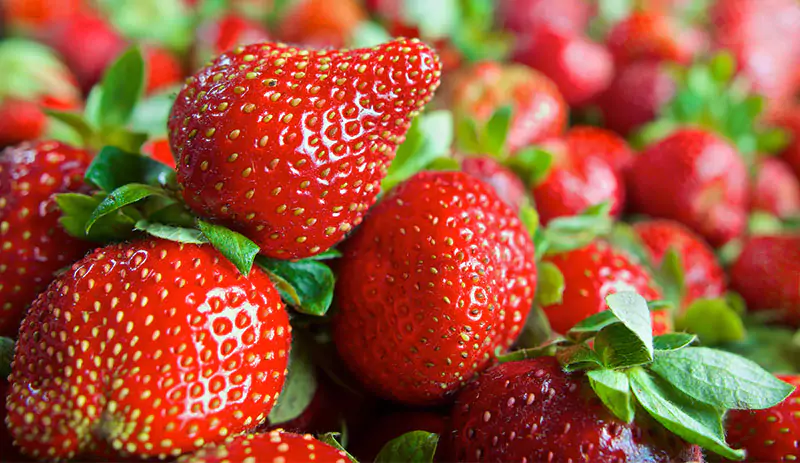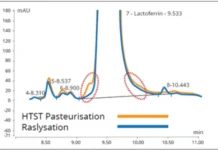IUVA Food and Beverage Safety Working Group
Over the last two decades, one of the most popular harvested fruits in the world has been the strawberry. Farmers in the US grew 1.6 billion pounds of strawberries, valued at nearly $3.5 billion. California produces more than 91% of the entire strawberry crop due to its temperate climate, allowing a 12-month growing season and producing a higher yield per acre than other states. Another significant reason for such high yields is the copious use of pesticides and fungicides to control pests such as insects, rodents, weeds, bacteria, mold and fungus.
But this dependence on chemistry comes at a cost. A recent US Department of Agriculture report found that more than 90% of random samples of strawberries tested positive for residues of two or more pesticides or fungicides. Although the Food Quality Protection Act (FQPA) stipulates that the Environmental Protection Agency (EPA) must ensure that all pesticides used on food in the US meet FQPA’s stringent safety standards and pose no discernable risk, consumer advocates strongly advise a significant reduction in pesticide exposures, citing research showing possible connections to pediatric cancer, fertility and neurological problems. Given the converging trend lines of greater consumption coupled with potential pesticide exposure risk, there is unmet need to demonstrate and deploy safe, affordable alternatives to ensure the economic well-being of suppliers and the long-term health of consumers, especially children.
With the stated aim of demonstrating nonchemical alternatives to fungicides and pesticides, the USDA Agriculture Research Service Fruit Research Station conducted experiments more than 10 years ago exposing strawberries to nontoxic and sensory quality-preserving germicidal ultraviolet light. The goal was to reduce spoilage-inducing powdery mildew and plant-destroying arthropod infestations in a convenient, safe and cost-effective manner. Researchers based their approach on a scientific paper published more than 60 years ago that implied that nighttime UV-C irradiation treatment was more effective than daytime treatment for killing plant disease-causing fungi.
Initial investigations showed promise in reducing pathogens and pests, as well as maintaining fruit sensory quality integrity. The team first demonstrated the effectiveness of germicidal UV-C against powdery mildew caused by Podosphaera aphanis. Low-dose treatments act as an effective fungal pathogen management approach through direct inactivation or by triggering production of plant fungi defense compounds. This approach also showed no negative side effects based upon botanists’ key plant health metrics, such as pollination, pollen viability, germ tube growth and photosynthesis functions. In other words, there was no yield risk, so it was concluded that it could be possible to meet consumer desire for organic or reduced health risk crop demand without undermining affordability.
The team then set its objective to showcase alternative tactics to control major pests. The dominating destructive insect is the leaf-eating two-spotted spider mite, T. urticae. This nuisance – along with a certain type of weevil, the adult sap beetle Paria fragariae, which also feeds on the roots of strawberries – causes significantly reduced photosynthetic activity, lower fruit weight, yield reduction and skin damage. The USDA group’s published studies reported that a nightly, 60-second exposure at low doses (0.237 Wm−2) decreased T. urticae populations by ∼ 97% over the entire plant and by 99% in the middle and upper portions of the canopy, and also reduced webbing on the upper leaves without producing phytotoxic effects on the strawberry plants.
Even with such initial experimental success, researchers noted that the limitation of the experimental optical set-up – which depended on inflexible and rigid conventional low-pressure, mercury-based germicidal lamps arranged in a semicircular pattern overhead – did not enable complete exposure access to all relevant surfaces of the plants tested, including the critical underside of leaves that harbor both the fungi and feeding mites. Undeterred, the ground-breaking USDA work has been continued via a long-term cooperation between several American universities, the Norwegian University of Life Science and a spin-out company called Saga Robotics. Even though the demand for their proposed solutions has generated significant interest amongst growers, it has taken almost 10 years to move the technology out of the greenhouse lab and into the fields. A commercial nighttime UV-C delivery system, Thorvald, is currently undergoing trials in Florida and the UK, and it is anticipated that the adoption road will continue to be long and winding.
However, with the recent availability of more powerful optical UV-C LED technology, with the flexiblity and creativity they can enable, new configurations could take advantage of greater optical reach and more complete illumination of the tops and bottoms of leaves, stems and spaces within the canopy itself, as well as finer dose control, allowing for more complete and uniform 3D exposures. This opens previously unavailable operational possibilities.
In conclusion, although the lighting industry’s focus has been entirely on optimizing LED-generated light for plant growth, the use of germicidal light to suppress plant pathogens and reduce pests has barely begun. Consumer health will be safeguarded by lowering risk of chemical exposure, and, from the strawberry’s perspective on its own well-being, “when the night is cloudy, there is still a light that shines on me. Shine until tomorrow. Let it UV.”
Peter E. Gordon
VP of business development
pgordon511@yahoo.com
Bolb Corporation
Livermore, California
The IUVA Food and Beverage Safety Working Group explores the latest updates on the science-based validation and commercialization of UV-C technology for food growth, production and transport applications from seed to stomach, as well as UV-C utilization for tea, milk and cold-pressed juice preservation.






